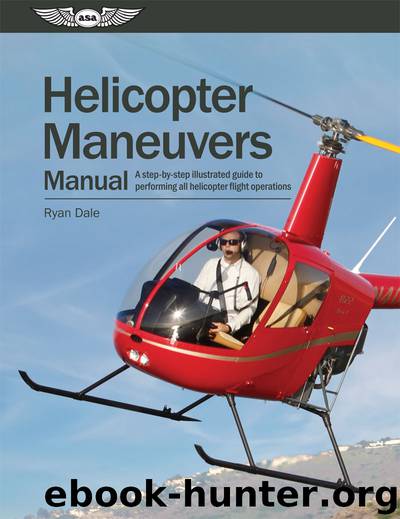Helicopter Maneuver's Manual by Ryan Dale

Author:Ryan Dale
Language: eng
Format: epub
Publisher: Aviation Supplies & Supplies, Inc.
Published: 2011-11-08T16:00:00+00:00
Start the takeoff by slowly raising the collective until the helicopter becomes light on its skids. While light on the skids, pause for a moment to neutralize all movements of the helicopter. Slowly increase the collective and position the cyclic so as to break ground and maintain a 40 KIAS attitude (approximately the same attitude as when the helicopter is light on the skids). Continue to slowly increase the collective until you reach the maximum power available. This large collective movement will require a substantial increase in left pedal to maintain heading.
At 50 feet of altitude or when clear of obstacles, slowly lower the nose by adding forward cyclic to a normal 60 KIAS climb attitude.
As the airspeed passes 60 KIAS, reduce the collective to normal climb power (hover power manifold pressure).
This takeoff can also be accomplished starting from a 3-foot hover.
Common Errors
• Failure to resume normal climb power/airspeed after passing over the obstacle.
• Once above ETL, failure to increase collective to resume maximum climb.
• Inability to stay within the limitations of the helicopter.
• Improper inputs to all 3 controls.
• Failure to do before takeoff check.
Tips
Don’t rush the maneuver; there should be a balance between obtaining ETL and continuing to climb. Keep in mind that with the high power settings, the collective must be lowered immediately if there is an engine failure. If this happens, you should also alter your takeoff course to land as safely as possible.
Private and Commercial PTS
Objective: To determine that the applicant—
1. Exhibits knowledge of the elements related to a maximum performance takeoff and climb.
2. Considers situations where this maneuver is recommended and factors related to takeoff and climb performance, including height/velocity information.
3. Maintains RPM within normal limits.
4. Utilizes proper control technique to initiate takeoff and forward climb airspeed attitude.
5. Utilizes the maximum available takeoff power.
6. After clearing all obstacles, transitions to normal climb attitude; airspeed, ±10 knots (for private) and ±5 knots (for commercial); and power setting.
7. Remains aware of the possibility of wind shear and/or wake turbulence.
8. Maintains proper ground track with crosswind correction, if necessary.
Download
This site does not store any files on its server. We only index and link to content provided by other sites. Please contact the content providers to delete copyright contents if any and email us, we'll remove relevant links or contents immediately.
| Airport | Commercial |
| Helicopters | History |
| Pictorial | Piloting & Flight Instruction |
| Repair & Maintenance |
Small Unmanned Fixed-wing Aircraft Design by Andrew J. Keane Andras Sobester James P. Scanlan & András Sóbester & James P. Scanlan(32141)
Navigation and Map Reading by K Andrew(4553)
Endurance: Shackleton's Incredible Voyage by Alfred Lansing(3840)
Wild Ride by Adam Lashinsky(1658)
And the Band Played On by Randy Shilts(1615)
The Box by Marc Levinson(1595)
Top 10 Prague (EYEWITNESS TOP 10 TRAVEL GUIDES) by DK(1567)
The Race for Hitler's X-Planes: Britain's 1945 Mission to Capture Secret Luftwaffe Technology by John Christopher(1526)
The One Percenter Encyclopedia by Bill Hayes(1463)
Girls Auto Clinic Glove Box Guide by Patrice Banks(1362)
Trans-Siberian Railway by Lonely Planet(1342)
Looking for a Ship by John McPhee(1320)
Fighting Hitler's Jets: The Extraordinary Story of the American Airmen Who Beat the Luftwaffe and Defeated Nazi Germany by Robert F. Dorr(1300)
Batavia's Graveyard by Mike Dash(1300)
Troubleshooting and Repair of Diesel Engines by Paul Dempsey(1284)
Bligh by Rob Mundle(1273)
TWA 800 by Jack Cashill(1253)
The Great Halifax Explosion by John U. Bacon(1229)
Ticket to Ride by Tom Chesshyre(1228)
